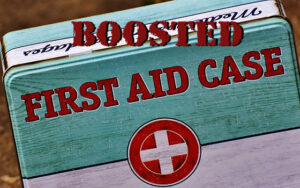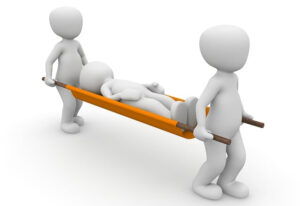BOOST your First Aid kit
Our philosophy is to learn how to take care of ourselves. Add to that the waiting times in ED, and we all need a good first aid kit. You can buy made up kits or you can put together your own, adding one or two items each week.
Basic First Aid Kit
According to www.firstaidkits.co.nz, a basic first aid kit should have:
- alcohol swabs
- antiseptic wipes
- bandages of varying widths
- combine dressing pads (10cm x 10cm)
- crepe plasters in different sizes
- disposable gloves
- disposable resuscitation face shield
- first aid booklet
- gauze swabs
- hypoallergenic tape
- non-adherent dressing pads (7.5cm x 10cm)
- safety pins
- saline solution to use as eye wash or wound wash
- scissors (sharp/blunt) 12.5cm
- stainless steel tweezers
- sterile eye pad
- sterile saline tubes/sachets
- survival blanket to assist people in shock – also can be used as a clean area to work on
- triangular bandage
For home use, also add:
- spray or gel for insect bites
- for cuts and grazes, we would recommend Opsite spray (acts as a second skinwhile healing takes place)
- instant ice packs to alleviate pain associated with bumps and bruises
- some sports tape is really useful with sport associated sprains
- a good burn gel or spray is recommended to treat common burn injuries caused by camp fires and barbeques
- antiseptic sprays or solution.
- skin closure plasters (also know as stitch plasters or steri-strips) to close open cuts and wounds and to help prevent scarring
- if going camping and spending time outdoors you may consider a good bug repellent
- plastic splints to immobilise possible fractures or heavy sprains
Then add extras to suit your family’s needs:
- For a vehicle, add reflective triangle, viz vest, a torch
- For babies – add extra items such as a digital thermometer, basic pain reliever medications and plastic syringes to help with accurate dosing
- For known medical conditions – add extra items, such as medicines and or equipment you normally use to manage the condition
Boosting your kit
But we like to have to improve our kits with natural products that can help in many situations.
Essential oils
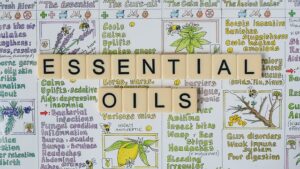 Essential oils such as lavender, tea tree, and peppermint can be used for minor first aid purposes.
Essential oils such as lavender, tea tree, and peppermint can be used for minor first aid purposes.
- Lavender can be used to soothe burns and cuts
- Tea tree for cleaning and disinfecting wounds
- Peppermint for relieving headaches and nausea.
First Aid Homeopathic Remedies
Homeopathy is a modality that can be used in acute, first-aid situations to alleviate symptoms quickly and effectively. Homeopathic remedies are easy to administer and safe to use with children, in pregnancy and when breastfeeding. They can be used for any type of ailment and can be found in your local health shop or pharmacy. For chronic ailments or multiple symptoms, it’s best to consult with a homeopath so they prescribe the correct remedy and dose.
These are the 5 First Aid Remedies most useful to have close-to-hand and when travelling – especially with children. When reaching for the paracetamol, consider using a homeopathic remedy.
Take one dose (suck to dissolve the remedy in the mouth) to promote the body’s own healing response and repeat another couple of doses if needed then stop. In a first aid situation a couple of doses, given as soon as possible, is usually sufficient.
1) Arnica 30c
Arnica is probably the most widely used of all remedies. It is used to treat injury and trauma (especially bruising and bleeding) and for shock associated with injury.
Two or three doses taken as soon as possible after injury and at intervals afterwards, if needed, help to alleviate pain, prevent bruising and bleeding and promote natural healing .
Arnica can also be applied to the bruised/injured area as a cream but avoid using on broken skin as it will sting.
Arnica can be taken in a ‘combination remedy’ with Rhus Tox and Ruta Gravis which is particularly useful when the injury involves a muscular strain or tendon sprain and where stiffness follows next morning.
2) Aconite 30c
A very useful first aid remedy for intense fear, panic and shock – usually with associated restlessness and anxiety.
For severe and recurrent panic attacks a higher potency might be needed for which you should consult a homeopath.
On a physical level this remedy helps relieve all sorts of acute inflammation and pain that comes on suddenly – often after exposure to wind or getting chilled.
Typically a child may develop painful earache, sore throat or headache after coming indoors after a cold, windy walk .
3) Belladonna 30c
A very useful remedy or acute fever and violent pains. The inflamed area may be intensely hot. Typically the symptoms are acute, red, hot and throbbing (eg a boil, abcess, earache, sore throat, sinusitis or headache). Touch or movement/jarring makes it worse. The cheeks or face of the feverish child are flushed, the eyes glisten and the pupils may be dilated whilst hands and feet may curiously be cold and the child is characteristically not thirsty.
Whilst waiting to get an appointment to see the doctor (for antibiotics perhaps), you could try a few doses of Belladonna.
4) Arsenicum Album 30c
Very useful for stomach upsets, diarrhoea and vomiting (eg travellers diarrhoea, food poisoning). Episodes are often followed by disproportionate exhaustion and prostration.
There is usually a feeling of great restlessness and anxiety. Symptoms are accompanied by thirst but just for small sips of a drink. Although the person may feel chilly and shivery, the symptoms usually feel ‘burning’ and sore.
5) Calendula & Hypericum cream – 30 gm tube
This cream is a must have for your first aid kit.
Made from organic plant extracts of Calendula (marigold) and Hypericum (St John Wort) this gentle soothing cream can be applied to cuts and grazes. The Calendula has an antiseptic action and the Hypericum soothes the raw pain of grazed skin and nerve endings.
Other useful remedies
- Apis Mel 30c – Main remedy for insect bites and stings which have swollen up. Redness and pain that is burning and stinging.
- Chamomilla 30c – Main remedy for teething children especially if a child has one red cheek. Characterised by over sensitivity. Suited to children who appear bad tempered, only quiet when carried and constantly change their minds.
- Ferrum Phos is a remedy you would use for a minor fever and swelling associated with the common cold, especially in the early stages where you can feel a little chilly.
Other
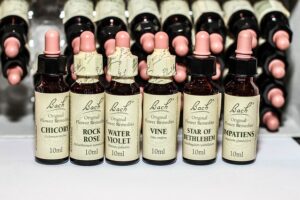 Rescue remedy
Rescue remedy
This may be used any kind of emergency or in circumstances when we need immediate help.
These Bach Flower drops help to bring calm, restore peace and emotional balance. It will help both the people affected and those who assist or watch.
Aloe Vera
Use to heal burns of any kind, kitchen burns, dry burns or scalding burns. Also used to reduce inflammation of any kind, skin rashes and irritations, insect bites and stings. Take an older leaf or part of the leaf, (as that part seals over), and split it to reveal a gelatinous substance and apply to the affected area. Some people are sensitive to the gel, so stop if the skin becomes irritated. Keep a plant in the kitchen it is very easy to grow.
Activated charcoal
Keep some capsules on hand for cases of food poisoning. Take 2 capsules with plenty of water. Then seek medical help.
Training and Equipment
Consider CPR or first aid training for at least one member of the household.
For a heart attack, CPR is vital, then you need to access a defibrillator asap. They’re easy to use yourself if the ambulance is a long way off or doesn’t arrive. Go to https://aedlocations.co.nz/ to locate your nearest public one before it’s needed.
Remember, what we’re discussing in this article is first aid, not final aid.
If home remedies don’t help, and a situation becomes severe, seek medical help.
How to Use An AED (Automated External Defibrillator)
If you’ve done a First Aid course, you’ll be familiar with your DRS ABCD. If you haven’t, these instructions are not enough, they are just a reminder – get a first aid book, or do some training.
- Assess the scene for Danger. The first rule of First Aid is to not put yourself in danger.
- Response – is the person conscious? Do they respond when you talk to them, touch their hands or squeeze their shoulder?
- Send for help
- Check the patients airways. Adjust their head position and clear the airway if necessary.
- Check their breathing
- CPR – if the patient is unconscious and not breathing, start CPR
- Defibrillator – get hold of one as soon as possible
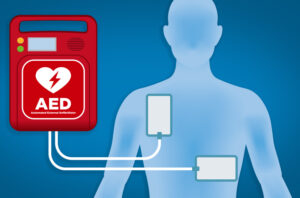 As soon as an AED is available, turn it on and follow the voice prompts. The prompts will guide you through the following:
As soon as an AED is available, turn it on and follow the voice prompts. The prompts will guide you through the following:
- Remove all clothing covering the chest. If necessary, wipe the chest dry. Place one pad on the upper right side of the chest. Place the other pad on the lower left side of the chest, a few inches below the left armpit. (If the pads may touch, place one pad in the middle of the chest and the other pad on the back, between the shoulder blades)
- Plug the pad connector cable into the AED, if necessary
- Prepare to let the AED analyze the heart’s rhythm. Make sure no one is touching the person. Say, “CLEAR!” in a loud, commanding voice
- If the AED determines a shock is needed, it will tell you to prepare to deliver it. Make sure no one is touching the person. Say, “CLEAR!” again. Push the “shock” button to deliver the shock.
- After the AED delivers the shock, or if no shock is advised, immediately restart CPR, beginning with compressions
Article originally written by myself & other practitioners from the Brooklyn Wellness Hub

